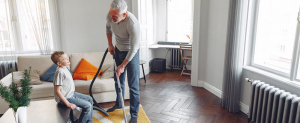5 Tips to Reduce Indoor Allergens

The trees are bare and frost is a daily battle again. At least winter means allergies are gone for another season, right? Not quite. While ragweed has died down, winter forces most of us indoors for the season, exposing us to different levels of indoor allergens like dust, mold, and pet dander.
The symptoms of indoor dust, mold, and pet allergies are that of typical allergies:
- Sneezing
- Runny or stuffy nose
- Red, itchy or teary eyes
- Wheezing, coughing, tightness in chest, and shortness of breath
- Itching
Environmental control products are helpful during the winter to keep indoor allergen levels low in your home. These products can help reduce the symptoms you experience.
Here are five tips to help reduce and prevent indoor allergens:
1. Replace Furnace Filters
Turning on the heat? Allergens like dust and pet dander can lurk in the air ducts. We recommend using a high-efficiency furnace filter to reduce the amount of harmful indoor allergens that circulate through your home. It is recommended that you change your air filter at least every 90 days; start changing it with the seasons to help you remember.
2. Change your Bedding
Dust mites are common indoor allergens that are found in pillows, mattresses, carpeting, and upholstered furniture. Encase mattresses, box springs, and pillows with allergen-proof covers; this can help minimize allergens you may encounter while you sleep. Washing your sheets and pillowcases in hot water at least once a week can also help keep dust mites at bay.
3. Clean Your House Regularly
Vacuuming with a HEPA filter at least once a week will also cut down on indoor allergens such as dust mites and pet dander. When dusting around your books and knick-knacks, use a microfiber or electrostatic cloth that will hold the dust instead of just moving it around. While you are dusting and vacuuming, dust will get stirred up in the air so, if you are allergic, use an N95 filter mask while cleaning.
When possible, we recommend avoiding wall-to-wall carpeting, especially in bedrooms. Hardwood floors are easier to clean, simply because you can see the dust when cleaning, however, you can also use washable area rugs to help cut down on allergens.
4. Avoid Pets Dander
Just like us, pets spend more time indoors during the winter. Pet allergens are found in the saliva and dander of cats and dogs, and no breed is allergy-free. Bathing pets once a week can help reduce the amount of dander they shed. Avoidance is key with animal allergies, however, after petting a cat or dog, washing your hands with soap and water can help keep symptoms from flaring. Remember to keep pets out of bedrooms and vacuum carpets often to reduce allergens as well.
5. Monitor Humidity Levels
Due to winter’s dry air, many use humidifiers in their homes to add moisture to the air. Humidifiers can prevent dryness, however, if you do not monitor the humidity levels you could be encouraging mold and dust mites to grow and live. Use a humidity meter to monitor the humidity in your home. The CDC recommends keeping it below 50% to reduce dust mites and mold and prevent them from growing. Use a dehumidifier if needed and remember to use a vent fan to remove moisture in bathrooms and the kitchen.
If your allergies get worse during the winter and avoidance or OTC medication isn’t working for you, schedule an appointment so we can help you find relief.


